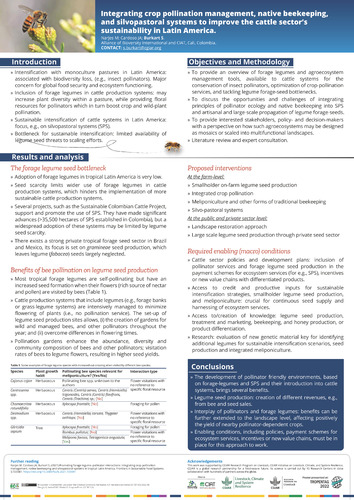Integrating crop pollination management, native beekeeping, and silvopastoral systems to improve the cattle sector’s sustainability in Latin America
Insect pollinator biodiversity and occurrence is on global decline, threatening human food supply and ecosystem functions. Extensive, pasture monoculture cattle production systems in tropical Latin America are among the principal drivers of this decline. This, in combination with other environmental problems caused by the conventional cattle sector, such as deforestation or greenhouse gas emissions, puts emphasis on the development of alternative, more sustainable production systems. One solution is the inclusion of forage legumes (fabaceae) in cattle production systems, for example as forage banks or within silvo-pastoral systems (SPS), which are mostly pollinated by insects, in particular bees. Such systems have been widely promoted to improve livestock production and soil fertility, but not to enhance ecosystem services from pollinators. Shortages of seed for the establishment of legumes as forage banks or within pastures or SPS remain a bottleneck for the improvement of ecosystem services brought about by pollinators within these systems and beyond. Against this background and based on literature review, we provide an overview of forage legumes, their interplay with pollinators, and the ecological and socio-economic benefits of pollinator–forage legume interactions, at different scales (farm and landscape level). We also discuss the challenges and opportunities of scaling these sustainably intensified cattle production systems that integrate legume forage-seed production with principles of pollinator ecology and native beekeeping. Our analysis shows that the main benefits include the provision of habitats for pollinators on decline and the promotion of legume seed required for the wider adoption of sustainable, forage-based cattle systems. This comes along with livelihood benefits for the producers, who can diversify (cattle production, legume seed production, honey making) and increase their incomes. At the landscape level, the interplay of pollinators and forage legumes can positively affect the yield of nearby pollinator-dependent crops. Finally, we provide interested stakeholders, policy- and decision-makers with a perspective on how such agroecosystems may be designed and scaled into multifunctional landscapes. This includes the improvement of enabling conditions, such as policies, knowledge transfer, payment schemes for ecosystem services, incentives, and new value chains.

